

Classics in the History of Psychology. Statistics Comparing Two Groups Tutorial. A common form of scientific experimentation is the comparison of two groups.
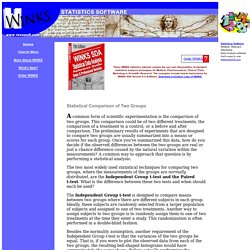
This comparison could be of two different treatments, the comparison of a treatment to a control, or a before and after comparison. The preliminary results of experiments that are designed to compare two groups are usually summarized into a means or scores for each group. Once you’ve summarized this data, how do you decide if the observed differences between the two groups are real or just a chance difference caused by the natural variation within the measurements?
A common way to approach that question is by performing a statistical analysis. T-TEST. Student's t-test We use this test for comparing the means of two samples (or treatments), even if they have different numbers of replicates.

In simple terms, the t-test compares the actual difference between two means in relation to the variation in the data (expressed as the standard deviation of the difference between the means). Procedure First, we will see how to do this test using "pencil and paper" (with a calculator to help with the calculations). Then we can see how the same test can be done in a spreadsheet package (Microsoft 'Excel') 1. If we are analysing the heights of pine trees growing in two different locations, a suitable null hypothesis would be that there is no difference in height between the two locations. 2. 3. 4. 5.
Correlation. « PreviousHomeNext » The correlation is one of the most common and most useful statistics.
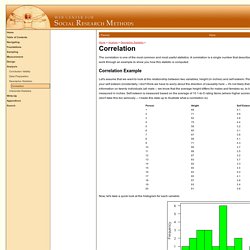
A correlation is a single number that describes the degree of relationship between two variables. Let's work through an example to show you how this statistic is computed. Correlation Example Let's assume that we want to look at the relationship between two variables, height (in inches) and self esteem. Now, let's take a quick look at the histogram for each variable: Correlation. When two sets of data are strongly linked together we say they have a High Correlation.
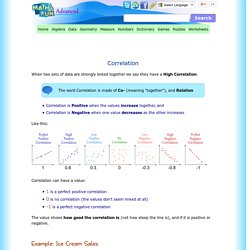
The word Correlation is made of Co- (meaning "together"), and Relation Correlation is Positive when the values increase together, and Correlation is Negative when one value decreases as the other increases. Behaviorism vs. Cognitivism. Timeline of Psychology. The History of Psychology. The Little Albert Experiment. Freud Complete Works. Sigmund Freud. Sigmund Freud (/frɔɪd/;[2] German pronunciation: [ˈziːkmʊnt ˈfʁɔʏ̯t]; born Sigismund Schlomo Freud; 6 May 1856 – 23 September 1939) was an Austrian neurologist, now known as the father of psychoanalysis.

Freud qualified as a doctor of medicine at the University of Vienna in 1881,[3] and then carried out research into cerebral palsy, aphasia and microscopic neuroanatomy at the Vienna General Hospital.[4] Upon completing his habilitation in 1895, he was appointed a docent in neuropathology in the same year and became an affiliated professor (professor extraordinarius) in 1902.[5][6] Psychoanalysis remains influential within psychotherapy, within some areas of psychiatry, and across the humanities. As such, it continues to generate extensive and highly contested debate with regard to its therapeutic efficacy, its scientific status, and whether it advances or is detrimental to the feminist cause.[10] Nonetheless, Freud's work has suffused contemporary Western thought and popular culture. Charles Darwin. English naturalist and biologist Charles Robert Darwin FRS FRGS FLS FZS[2] (;[5] 12 February 1809 – 19 April 1882) was an English naturalist, geologist and biologist,[6] best known for his contributions to the science of evolution.

[I] His proposition that all species of life have descended over time from common ancestors is now widely accepted, and considered a foundational concept in science.[7] In a joint publication with Alfred Russel Wallace, he introduced his scientific theory that this branching pattern of evolution resulted from a process that he called natural selection, in which the struggle for existence has a similar effect to the artificial selection involved in selective breeding.[8] Darwin has been described as one of the most influential figures in human history,[9] and he was honoured by burial in Westminster Abbey.[10] Biography Early life and education Chalk drawing of the seven-year-old Charles Darwin in 1816, already with a potted plant, by Ellen Sharples Legacy Children.
Wilhelm Wundt. Wilhelm Maximilian Wundt (; German: [vʊnt]; 16 August 1832 – 31 August 1920) was a physician, physiologist, philosopher, and professor, known today as one of the founders of modern psychology.
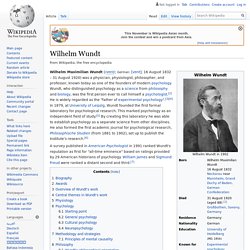
Wundt, who distinguished psychology as a science from philosophy and biology, was the first person ever to call himself a psychologist.[2] He is widely regarded as the "father of experimental psychology".[3][4] In 1879, at University of Leipzig, Wundt founded the first formal laboratory for psychological research. This marked psychology as an independent field of study.[5] By creating this laboratory he was able to establish psychology as a separate science from other disciplines. He also formed the first academic journal for psychological research, Philosophische Studien (from 1881 to 1902), set up to publish the Institute's research.[6]
Ernst Heinrich Weber. Ernst Heinrich Weber (June 24, 1795 – January 26, 1878) was a German physician who is considered one of the founders of experimental psychology.
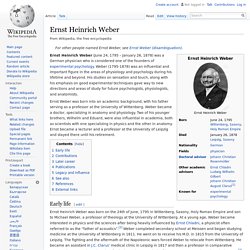
Weber (1795-1878) was an influential and important figure in the areas of physiology and psychology during his lifetime and beyond. His studies on sensation and touch, along with his emphasis on good experimental techniques gave way to new directions and areas of study for future psychologists, physiologists, and anatomists. Ernst Weber was born into an academic background, with his father serving as a professor at the University of Wittenberg. Weber became a doctor, specializing in anatomy and physiology. Hermann von Helmholtz. Helmholtz's polyphonic siren, Hunterian Museum, Glasgow Hermann Ludwig Ferdinand von Helmholtz (August 31, 1821 – September 8, 1894) was a German physician and physicist who made significant contributions in several scientific fields.
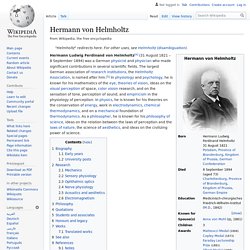
The largest German association of research institutions, the Helmholtz Association, is named after him.[5] Materialism. Materialism is a form of philosophical monism that holds that matter is the fundamental substance in nature, and that all things, including mental states and consciousness, are results of material interactions.

According to philosophical materialism, mind and consciousness are by-products or epiphenomena of material processes (such as the biochemistry of the human brain and nervous system), without which they cannot exist. This concept directly contrasts with idealism, where mind and consciousness are first-order realities to which matter is subject and material interactions are secondary. Materialism is closely related to physicalism—the view that all that exists is ultimately physical. Philosophical physicalism has evolved from materialism with the theories of the physical sciences to incorporate more sophisticated notions of physicality than mere ordinary matter (e.g. spacetime, physical energies and forces, and dark matter).